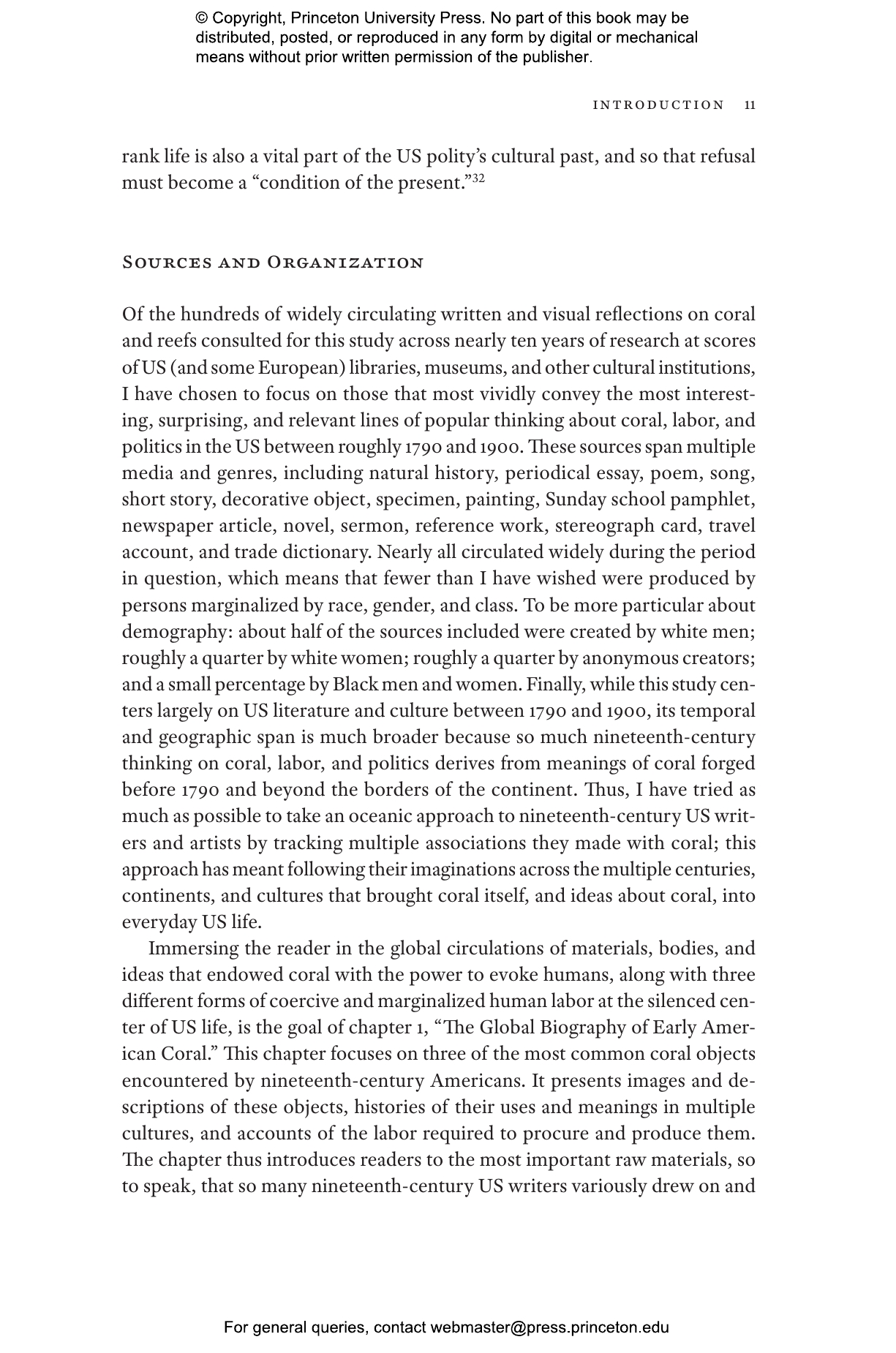Today, coral and the human-caused threats to coral reef ecosystems symbolize our ongoing planetary crisis. In the nineteenth century, coral represented something else; as a recurring motif in American literature and culture, it shaped popular ideas about human society and politics. In Coral Lives, Michele Currie Navakas tells the story of coral as an essential element of the marine ecosystem, a cherished personal ornament, a global commodity, and a powerful political metaphor. Drawing on a wide range of sources, including works by such writers as Sarah Josepha Hale, Harriet Beecher Stowe, Frances Ellen Watkins Harper, and George Washington Cable, Navakas shows how coral once helped Americans to recognize both the potential and the limits of interdependence鈥攖o imagine that their society could grow, like a coral reef, by sustaining rather than displacing others.
Navakas shows how coral became deeply entwined with the histories of slavery, wage labor, and women鈥檚 reproductive and domestic work. If coral seemed to some nineteenth-century American writers to be a metaphor for a truly just collective society, it also showed them, by analogy, that society can seem most robust precisely when it is in fact most unfree for the laborers sustaining it. Navakas鈥檚 trailblazing cultural history reveals that coral has long been conceptually indispensable to humans, and its loss is more than biological. Without it, we lose some of our most complex political imaginings, recognitions, reckonings, and longings.
"Solidifying her place as one of the more imaginative cultural historians working today, Michele Currie Navakas provides a living ‘biography’ of coral in nineteenth-century America. This remarkably researched and clearly written volume restores the place of these jewel-like habitats in the literary and popular imagination."鈥擳homas Hallock, Nineteenth-Century Literature
"Smart and fascinating. . . . To see coral through the eyes of the myriad sources brought together here is to be stunned by what we have lost, are losing—not merely coral itself, but our memory and knowledge of it, our relationship to the very past the coral lives of our ancestors built and bequeathed to us, trusting us to keep building, to keep alive, the surprises of life’s ceaseless becomings."鈥擫aura Dassow Walls, The Review of English Studies
"A wonderfully interesting book, fresh and exciting, a tour de force that shows how history, art, politics and literature interweave with the natural history of these extraordinary organisms."鈥擩anet Browne, Archives of Natural History
"Coral Lives takes an unexpected approach to the environmental humanities. It does not trace a genealogy of coral as a vanishing object reflecting increasing anthropogenic damage to the natural world; Instead, it recollects meanings that are all but lost to us today. But it is the potential inspiration that inheres in the act of recovering lost narratives that gives this book value in the current crisis."鈥擠ana Luciano, ISLE: Interdisciplinary Studies in Literature and Environment
"[An] eloquent book. . . . Navakas integrates so many sources so well and with such a sharp eye on the complexities of race, cultural patterns, and global subjects that this book will become a ready model for scholarship in the environmental humanities."鈥擪atharine Anderson, H-Environment
"An interdisciplinary history of discourse, with elements of natural science, political discourse, history of ideas, history of everyday life and material history. . . . Navakas writes a highly inclusive narrative, combining points of view from various social classes, races, genders, professions, and ages."鈥擯awel Stachura,, European Journal of American Studies
"Michele Currie Navakas gives a compelling and incisive literary and cultural history of the ways that American writers and thinkers turned to coral—a material that circulated widely in the nineteenth-century United States—as a model of and metaphor for political collectivity."鈥擫eila Mansouri, 聽Journal of the Early Republic
“Coral—now rare and vanishing, once ubiquitous and proliferating—was embedded in nineteenth-century America. In this original and fascinating book, Michele Currie Navakas shows how diverse Americans used coral to think through changing formations of labor, capitalism, and life—human and otherwise. Navakas’s study stretches across oceans and dives into them, recovering the cultural work of coral from global politics to the smallest red-orange bead on an enslaved child’s neck. An exciting contribution to the environmental humanities, this lustrous book tells us why coral mattered to the nineteenth-century imagination—and why we need coral to think with now.”—Robin Bernstein, author of Racial Innocence: Performing American Childhood from Slavery to Civil Rights
“Coral Lives is a thought-provoking ocean-centric history of human relationships with the sea. Navakas imaginatively considers the cultural and material valuations that Atlantic Africans, members of the African diaspora, and Indigenous peoples throughout the Americas and Pacific affixed to coral and how white Americans and Europeans drew upon this knowledge to harvest coral, employing it as models for complex social relationships.”—Kevin Dawson, author of Undercurrents of Power: Aquatic Culture in the African Diaspora
“Navakas’s scholarship is utterly sound; her writing is fluid and clear. She stakes out new ground in this first cultural biography of American coral.”—Susan Scott Parrish, University of Michigan
“This study is an extraordinarily significant contribution to the field. Navakas weaves her argument out of a stunning array of source materials, presenting new data but also new conceptions and interpretations.”—Marion Rust, University of Kentucky

























